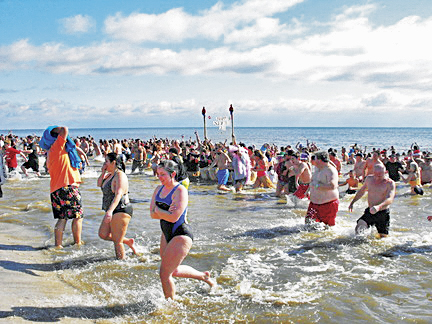December 15, 2010 issue
Arts & Entertainment
Celebrating the New Year around the world

It's New Year's Day 2011 as I'm writing this. At midnight, fireworks lit the sky on the Gulf of Mexico on South Padre Island, Texas, where we recently arrived to spend the winter. Every country and culture seem to celebrate New Year in their own fashion. Here on South Padre Island, besides the fireworks, they jump into the Gulf of Mexico for an early morning dip. In Port Dover in Norfolk County, Ontario, where we live, they make a hole in the ice in Lake Erie and brave, foolhardy souls do a Polar Bear dip into it, with an ambulance waiting nearby.
In Australia, New Year's Eve is called Sylvesterabend which is the Eve of Saint Silvester, The Aussies make a punch of cinnamon, sugar, and red wine to honour the Saint. Taverns and inns are decorated with evergreen wreaths. There are streamers, confetti and champagne. The evil spirits of the Old Year are chased away by the firing of mortars called “boller” (my cannon would be useful there).
In Guyana there are many traditions and folklore to drive away the evil spirits and bring good luck in the New Year including sweeping the house clean on New Year's Eve and having a larder stocked full of food.

In Brazil, priestesses of the local Macumba voodoo cult dress in blue skirts and white blouses for a ceremony dedicated to the goddess of water - Yemanja. A sacrificial boat laden with flowers, candles, and jewelry is pushed out to sea from Brazil's famous Ipanema Beach in Rio de Janeiro.
In the Far East, at the celebration of the Buddhist New Year, folks squirt water on whomever they meet in the streets, just like kids having a water gun fight.
In Germany, people drop molten lead into water and try to tell the future from the shape made. A heart or ring shape means a wedding, a ship means a journey, and a pig means plenty of food in the New Year. Folks leave a bit of food on their plates until midnight, a way of ensuring food in the New Year.
The Japanese New Year – Oshogatsu, is a family celebration and a holiday. To keep out evil spirits, they hang a rope of straw across the front of their houses for good luck. As soon as the New Year strikes, people start laughing, keeping it up for as long as they can – the longer you laugh, the more luck for you in the New Year.
In Korea, the first day of the New Year is called Sol-nal. Folks place straw scoopers, rakes and sieves on their doors, and walls to protect their families from evil spirits in the New Year. Everyone dresses in new clothes symbolizing a fresh beginning.
In the Netherlands, New Year is the time to burn your Christmas trees in street bonfires and also let off fireworks to drive off the evil spirits.
The Scottish New Year's is known as Hogmanay – Night of the Candle. Three-cornered biscuits called Hogmanays are eaten.
In the South pacific, folks look into the sky for the group of stars called the Pleiades in Mid-October. I believe that my father called these stars the Seven Sisters as they shone brightly at Christmas time in Guyana. In parts of the Pacific, the Pleiades marks the end of the harvesting season and the end of the year. It is celebrated by the festival of Makahki. It is a time for feasting, frolic, sports and a time to make peace and truces with your enemies.
Now you see how important New Year's is to folks around the world. Everyone tries to get rid of the evil within (bad habits, bad blood) and the evil without (bad luck, bad spirits). New Year coming on the heels of Christmas is a fitting end to the year, even though you have to take at least half of the New Year to pay off your Christmas debts!
Guyana Boy will continue to keep you posted on his travels and adventures so stay tuned. In the meanwhile, Walk Good and have a Happy and Prosperous New Year. If the creeks don't rise and the sun still shines I'll be talking to you.